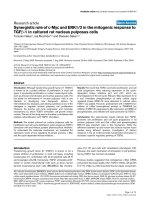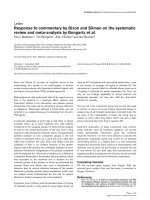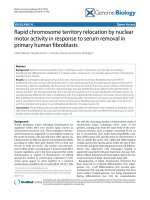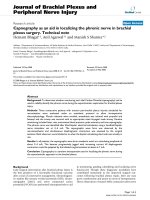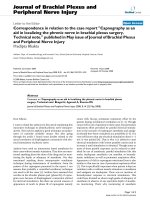Báo cáo y học: "Response to comments on "Capnography as an aid in localizing the phrenic nerve in brachial plexus surgery. Technical note"" docx
Bạn đang xem bản rút gọn của tài liệu. Xem và tải ngay bản đầy đủ của tài liệu tại đây (170.77 KB, 2 trang )
BioMed Central
Page 1 of 2
(page number not for citation purposes)
Journal of Brachial Plexus and
Peripheral Nerve Injury
Open Access
Letter to the Editor
Response to comments on "Capnography as an aid in localizing the
phrenic nerve in brachial plexus surgery. Technical note"
Hemant Bhagat
1
, Anil Agarwa
1
and Manish S Sharma*
2
Address:
1
Department of Neuroanesthesia, All India Institute of Medical Sciences, New Delhi-110029, India and
2
Department of Neurosurgery,
All India Institute of Medical Sciences, New Delhi-110029, India
Email: Hemant Bhagat - ; Anil Agarwa - ;
Manish S Sharma* -
* Corresponding author
Abstract
Response to comments on 'Capnography as an aid in localizing the phrenic nerve in brachial plexus
surgery. Technical note' Bhagat H, Agarwal A, Sharma MS Journal of Brachial Plexus and Peripheral
Nerve Injury 2008, 3:14 (22 May 2008)
Dear Editors,
We appreciate the concerns raised by the reader as they are
genuine and focused. Monitoring the depth of anaesthesia
with aid of specific monitors is a good idea. In our study,
the doses of drugs used were according to the standard
anaesthetic practice for total intravenous anaesthesia
which should not warrant concerns regarding the ade-
quacy of the depth of anaesthesia. Anaesthesia was
induced with propofol 1.5–2 mg/kg and fentanyl 2 μg/kg
while maintenance of anaesthesia was with propofol 6–
10 mg/kg/hour. Fentanyl was administered at a dose of 1
μg/kg prior to skin incision and thence every 30 minutes
to ensure adequate analgesia. The propofol infusions were
adjusted according to increase in heart rate and/or blood
pressure to more than 20% of baseline values. With this
anaesthetic technique and use of laryngeal mask airway
we were able to use controlled ventilation in all our
patients. The idea of using controlled ventilation was to
abolish the respiratory efforts and consequently have a
uniform capnograph which would enable us to appreciate
any changes in response to electrical stimulation of
phrenic nerve.
Premature respiratory efforts because of inadequate
anaesthesia and analgesia can cause similar pattern in the
capnograph as reported by us. However we ensured ade-
quate depth of anaesthesia and analgesia based on the
haemodynamic response to surgery. The titration of
anaesthesia based on haemodynamic parameters have
been found to be sufficient to ensure adequate depth of
anaesthesia [1]. The hemodynamic response to phrenic
nerve stimulation was unremarkable.
Hiccups can occur during phrenic nerve stimulation. This
is what we have exactly tried to explain. This novel tech-
nique is being described to localize the phrenic nerve in
an otherwise scarred tissue. Consequently, the stimula-
tion was attempted in and around the phrenic nerve,
which may result in incomplete diaphragmatic contrac-
tion.
The ventilator rate and tidal volume were adjusted to
maintain an end-tidal carbon dioxide (ETCO
2
) between
35–40 mmHg. Following electrical stimulation around
the phrenic nerve with lower amplitude of electric current,
there is subclinical diaphragmatic contraction (mimick-
ing premature inspiratory efforts) and a fall in ETCO
2
.
Published: 22 October 2008
Journal of Brachial Plexus and Peripheral Nerve Injury 2008, 3:21 doi:10.1186/1749-7221-3-21
Received: 17 October 2008
Accepted: 22 October 2008
This article is available from: />© 2008 Bhagat et al; licensee BioMed Central Ltd.
This is an Open Access article distributed under the terms of the Creative Commons Attribution License ( />),
which permits unrestricted use, distribution, and reproduction in any medium, provided the original work is properly cited.
Publish with BioMed Central and every
scientist can read your work free of charge
"BioMed Central will be the most significant development for
disseminating the results of biomedical research in our lifetime."
Sir Paul Nurse, Cancer Research UK
Your research papers will be:
available free of charge to the entire biomedical community
peer reviewed and published immediately upon acceptance
cited in PubMed and archived on PubMed Central
yours — you keep the copyright
Submit your manuscript here:
/>BioMedcentral
Journal of Brachial Plexus and Peripheral Nerve Injury 2008, 3:21 />Page 2 of 2
(page number not for citation purposes)
With increase in the amplitude of current, there is further
increase in the force of diaphragmatic contraction (akin to
hiccups) with additional fall in ETCO
2
.
We hope the response addresses the concerns of the
reader.
Thanking you
Hemant Bhagat, Anil Agarwal, Manish S Sharma
Competing interests
The authors declare that they have no competing interests.
They did not receive any grants nor do they have any
vested interests in the equipment described.
References
1. Akcali DT, Ozkose Z, Yardim S: Do we need bispectral index
monitoring during total intravenous anesthesia for lumbar
discectomies. Turk Neurosurg 2008, 18:125-33.
